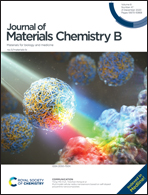Development of an antibacterial and anti-metalloproteinase dental adhesive for long-lasting resin composite restorations
Abstract
Despite all the advances in adhesive dentistry, dental bonds are still fragile due to degradation events that start during application of adhesive agents and the inherent hydrolysis of resin–dentin bonds. Here, we combined two outstanding processing methods (electrospinning and cryomilling) to obtain bioactive (antimicrobial and anti-metalloproteinase) fiber-based fillers containing a potent matrix metalloproteinase (MMP) inhibitor (doxycycline, DOX). Poly(ε)caprolactone solutions containing different DOX amounts (0, 5, 25, and 50 wt%) were processed via electrospinning, resulting in non-toxic submicron fibers with antimicrobial activity against Streptococcus mutans and Lactobacillus. The fibers were embedded in a resin blend, light-cured, and cryomilled for the preparation of fiber-containing fillers, which were investigated with antibacterial and in situ gelatin zymography analyzes. The fillers containing 0, 25, and 50 wt% DOX-releasing fibers were added to aliquots of a two-step, etch-and-rinse dental adhesive system. Mechanical strength, hardness, degree of conversion (DC), water sorption and solubility, bond strength to dentin, and nanoleakage analyses were performed to characterize the physico-mechanical, biological, and bonding properties of the modified adhesives. Statistical analyses (ANOVA; Kruskal–Wallis) were used when appropriate to analyze the data (α = 0.05). DOX-releasing fibers were successfully obtained, showing proper morphological architecture, cytocompatibility, drug release ability, slow degradation profile, and antibacterial activity. Reduced metalloproteinases (MMP-2 and MMP-9) activity was observed only for the DOX-containing fillers, which have also demonstrated antibacterial properties against tested bacteria. Adhesive resins modified with DOX-containing fillers demonstrated greater DC and similar mechanical properties as compared to the fiber-free adhesive (unfilled control). Concerning bonding performance to dentin, the experimental adhesives showed similar immediate bond strengths to the control. After 12 months of water storage, the fiber-modified adhesives (except the group consisting of 50 wt% DOX-loaded fillers) demonstrated stable bonds to dentin. Nanoleakage was similar among all groups investigated. DOX-releasing fibers showed promising application in developing novel dentin adhesives with potential therapeutic properties and MMP inhibition ability; antibacterial activity against relevant oral pathogens, without jeopardizing the physico-mechanical characteristics; and bonding performance of the adhesive.



 Please wait while we load your content...
Please wait while we load your content...